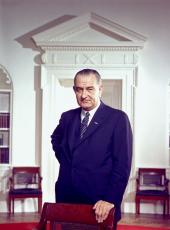Governor Tawes, Members of the Congress, my friends:
Over the years, I have found two distinct schools of thought around Washington in regard to Senators. One holds that Senators should be treated like people. The other school is somewhat more revolutionary and holds that people should be treated like Senators.
The bill I am about to sign today represents a victory for the second school of thought.
So, henceforward, the people--including the House Members--will have what only Senators have enjoyed until now: high-speed subways to take them to and from their work.
Here in the District of Columbia, justice has been long delayed and long denied on many matters, although I am proud the pace of progress is picking up somewhat this year. I believe this legislation means justice and .progress at long last for the residents of our great National Capital.
On an average weekday more people enter and leave downtown Washington than visit Manhattan Island in New York City. Unless we want to pave the Potomac with bridges, there is little more that we can do to ease the congestion until we have properly balanced our transportation system. And that is what this bill permits us to do.
The metropolitan area's highway system has been planned on the assumption that it would be balanced by a rapid rail system. And I congratulate the Congress on following through to make this balance feasible.
Our goal must be to make the suburbs of Maryland and Virginia a part of this system. The Maryland Legislature has already approved the compact to make that possible-and we hope that Virginia will do the same in 1966.
We all realize the significance of this measure reaches beyond the Federal City itself. If we are to realize the full promise of tomorrow's urbanized America, we must all-across our land--meet today the pressing challenge of urban transportation.
Today there are 75 million automobiles in use in this country. In only 15 more years, by 1980, that number will exceed 106 million.
Over the next 10 years, by 1975, the total vehicle miles traveled in the Nation's urban areas will increase by more than 64 percent.
Our great interstate highway program is meeting the needs for intercity and cross-country travel in this highly mobile Nation of ours. But we must not forget that of the 150 million automobile trips made each day in our metropolitan areas--to percent of them are for distances of less than 5 miles.
Our most acute transportation problem-one that costs us billions of dollars each year now--is that of local traffic. In a day when our astronauts can circle the globe in less time than many Americans spend driving to and from work, our challenge is real, and it is serious, and it is urgent.
This bill will help us to fulfill our goal of making the District of Columbia the model city for the Nation that Washington ought to be. So I want to express my very deep appreciation, my personal thanks. I want to congratulate all in the Congress for the enthusiastic bipartisan support which made possible its passage.
As one who still remembers the years of fighting the traffic in Rock Creek Park-when they still let me do my own driving-I am personally pleased to be able to sign this very important and this very long-needed piece of legislation.
Thank you very much.
Note: The President spoke at 10:04 a.m. in the Rose Garden at the White House. In his opening words he referred to Governor J. Millard Tawes of Maryland.
As enacted, the National Capital Transportation Act of 1965 is Public Law 89-173 (79 Stat. 663).
Lyndon B. Johnson, Remarks at the Signing of the National Capital Transportation Act Online by Gerhard Peters and John T. Woolley, The American Presidency Project https://www.presidency.ucsb.edu/node/240623


